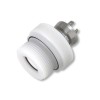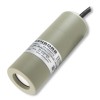The first step in selecting a pressure transmitter for liquid level measurement is to determine whether to submerge or mount the sensor externally.
Mounting a liquid level pressure transmitter externally is nearly always preferable because a screw in pressure transmitter is normally cheaper than one that is immersed, and is easier to service.
If you are mounting a liquid level pressure transmitter externally, care should be taken not to install it onto pipes where there is likely to be a high flow of liquid or pump pressures since these may interfere with the hydrostatic pressure reading.
Waterproof pressure transmitters are used when it is not possible to provide access from the outside at the point you would like to measure the liquid level. For example there is no way to fit a pressure transmitter to the outside of a buried water storage tank without excavating the ground around it, so a waterproof pressure transmitter is the most economical solution.
Normally a manufacturer will clearly describe in the specification whether a pressure transmitter has an immersion option. In Europe there is a system for rating the level of water tightness which is the Ingress Protection Rating or more commonly known as the IP Rating. For immersion the pressure transmitter should be sealed to a rating of IP68. If it is not clearly marked in the literature you should clarify with the manufacturer for what depth and duration it can be submerged.
Related Help Guides
- Measuring the volume of liquid in a horizontal cylinder tank
- Determining water tank volume using hydrostatic pressure
- Choosing PVC, PUR, FEP and TPE cable types



